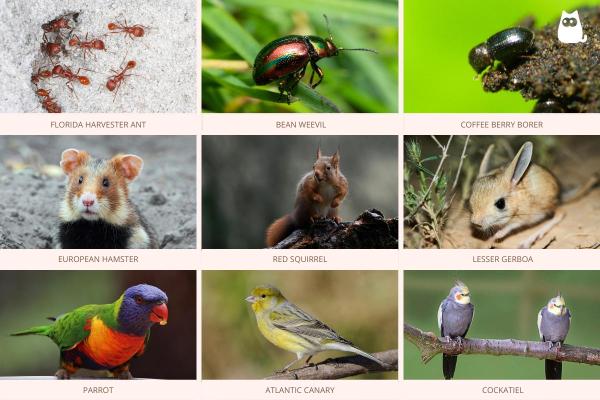Granivore
A granivore is an organism that primarily consumes seeds as a significant part of its diet. These seeds can come from various plants, including grasses, grains, and other seed-bearing vegetation. Granivores are a type of herbivore, which means they primarily feed on plant material. These specialized herbivores have adaptations in their anatomy and behavior that allow them to efficiently consume and digest seeds.
Diet:
Seed Consumption: Granivores are specialized in consuming seeds as a major part of their diet. Seeds are rich in nutrients and often serve as an energy-dense food source.
Types of Seeds: Granivores may consume a variety of seeds, ranging from grass seeds to the seeds of flowering plants, depending on their ecological niche.
Anatomy and Adaptations:
Dentition: Granivores often have specialized dentition adapted for seed consumption. This may include strong, robust beaks or teeth that can crack open hard seed coats.
Digestive System: Some granivores have digestive systems that are well-adapted to process seeds. This may involve specialized stomach chambers or symbiotic relationships with microorganisms that aid in breaking down tough seed coatings.
Behavior:
Foraging Techniques: Granivores employ various foraging techniques to locate and extract seeds from plants. This may involve ground foraging, tree climbing, or specialized feeding behaviors.
Seed Storage: Some granivores have the ability to store seeds for later consumption. This is often seen in birds, where they may hide or cache seeds in different locations.
Ecological Importance:
Granivores play a crucial role in seed dispersal. By consuming seeds and then moving away from the parent plant, they help in the distribution and germination of plants across different locations.
They also influence plant communities and ecosystems by affecting the abundance and distribution of plant species.
Challenges:
Competition: Granivores may face competition with other herbivores for limited seed resources. The ability to find and access seeds is essential for their survival.
Examples of Granivores:

Birds:
Sparrows: Sparrows are common granivorous birds that feed on a variety of seeds found in grasses, weeds, and crops.
Finches: Finches, such as the famous Darwin’s finches, are known for their specialized beaks adapted for cracking open different types of seeds.
Pigeons and Doves: These birds often consume seeds as a significant part of their diet.
Rodents:
Squirrels: Squirrels are granivores that eat a variety of seeds, nuts, and acorns. They play a role in seed dispersal by burying and forgetting some of the seeds they collect.
Mice: Some species of mice are granivores, feeding on seeds as part of their diet.
Insects:
Granivorous Insects: Certain insects, such as beetles and ants, may have a diet that includes seeds. They can be important for seed predation and dispersal.
Reptiles:
Tortoises: Some species of tortoises are granivores, consuming seeds along with other plant material. They often play a role in seed dispersal through their digestive processes.
Fish:
Granivorous Fish: Certain fish species, particularly those that inhabit freshwater environments, may consume seeds along with other plant matter.
Other Mammals:
Hamsters: Pet hamsters, for example, are granivores and are often fed a diet consisting of seeds and grains.
Chipmunks: Similar to squirrels, chipmunks are granivores that gather and store seeds for consumption.
Appreciating Granivores for Their Ecological Mastery
Granivores emerge as fascinating specialists in the vast realm of herbivores. Their ability to adapt anatomically and behaviorally to a seed-centric diet showcases the intricacies of nature’s design. From the bustling world of avian granivores to the subtle activities of rodents and insects, these seed-eating specialists weave an ecological narrative that highlights their vital role in shaping and sustaining ecosystems. As stewards of seed dispersal and influencers of plant community dynamics, granivores deserve our appreciation for the intricate dance they perform in the grand theater of nature.